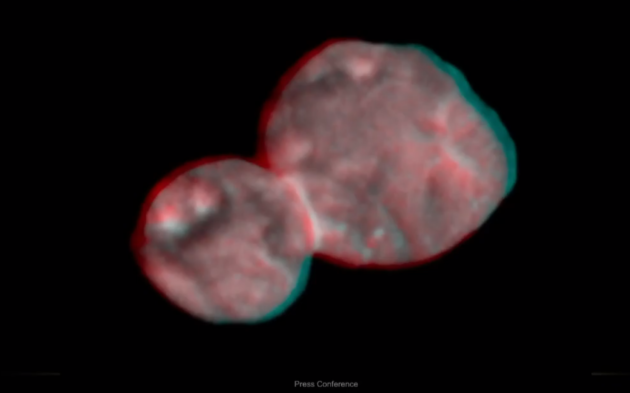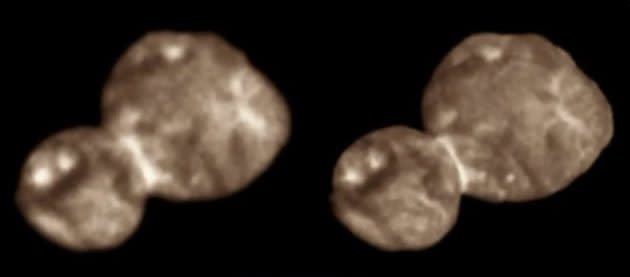New Horizons probe delivers 3-D views of cosmic snowman, plus mysteries to solve

LAUREL, Md. — The science team behind NASA’s New Horizons spacecraft today released the first 3-D image of an icy object more than 4 billion miles from Earth, and the variations in the picture hint at ridges, craters and knobby features that will be more fully charted as the resolution improves.
Two pictures, separated by just a moment in time, were fused together to produce a somewhat fuzzy but depth-enabled glimpse at the object — which has the official designation of 2014 MU69 but has been nicknamed Ultima Thule by the New Horizon team.
“Features appear to be rotating into view as the object twists underneath us,” Paul Schenk, a New Horizons co-investigator from the Lunar and Planetary Institute, said during today’s briefing here at Johns Hopkins University’s Applied Physics Laboratory. “These have a knobby appearance, and could be the inside of a large impact crater that’s on the far side.”
The stereo view also appears to highlight ridge structures on the 19-mile-long object, which has been compared in appearance to a snowman or the BB-8 droid from “Star Wars.” Some of the ridges could represent elevation variations amounting to several hundred feet, he said.
Schenk said a side-by-side version of the 3-D images was created by Brian May, an astrophysicist specializing in scientific stereoscopy who also happens to be the lead guitarist for the classic rock group Queen.
New Horizons’ researchers emphasized that their findings were still highly tentative, coming only three days after New Horizons zoomed past Ultima Thule at 32,000 mph, at a distance as close as 2,200 miles.
The mission’s principal investigator, Alan Stern of the Southwest Research Institute, said the piano-sized spacecraft has already gone 3 million miles beyond Ultima, blazing a trail through a sparsely populated, icy zone of the solar system known as the Kuiper Belt.
Today the probe made its final observations looking back at the environment around Ultima Thule, a Latin term that signifies “a place beyond the known world,” and turned its instruments to the unknown worlds ahead, Stern said. He said data transmissions back to Earth will be suspended for several days due to solar interference, and resume on Jan. 10.
It’ll take 20 months to downlink several gigabytes’ worth of data from the close flyby on the night of Dec. 31-Jan. 1, due to New Horizons’ limited transmission capability and the extreme distances involved.
The Ultima encounter is the latest chapter in a saga that began with New Horizons’ launched in 2006 and reached a crescendo in 2015 when the probe flew past Pluto. Even before the Pluto flyby, the mission team identified 2014 MU69 — a billion miles beyond Pluto — as a worthy follow-up target. Part of the reason for looking ahead now could well be to identify yet another Kuiper Belt object for close study.
Along the way, New Horizons’ instruments will continue to sample the solar wind and particle flux in the solar system’s least-explored zone.
Zoom with a view: Made from two images taken 38 minutes apart, here is #UltimaThule! The "Thule" lobe is closest to the @NASANewHorizons spacecraft. As Ultima Thule is seen to rotate, hints of the topography can be perceived. @NASAhttps://t.co/fKsyLeW9pY pic.twitter.com/5S9zZ5d3Eg
— Johns Hopkins APL (@JHUAPL) January 3, 2019
Many mysteries still surround Ultima, which scientists see as a relic of the early solar system that looks much as it did 4.5 billion years ago. One mystery has to do with the object’s snowman shape.
Mark Showalter, a New Horizons team member from the SETI Institute, said the fact that Ultima has two roundish lobes would suggest that it was once surrounded by moonlets or other debris.
That surmise is based on a series of computer simulations for the formation of planetesimals like Ultima. The outlying objects would have carried off enough angular momentum to allow the two largest objects to fuse together gently.
“A very common scenario was two objects in the center, and a few more objects outside,” Showalter said.
Showalter said “we’re looking for the objects that put on the brakes.” But no moons or rings of material have been detected in the imagery that’s been downlinked so far.
Such features could show up on imagery yet to be sent back to Earth. But there’s also a good chance that the outlying objects went their own way long ago. “It’s quite possible that we will never actually see the culprit,” Showalter said.
Other scientists are looking for any signs of a faint atmosphere or a haze of dust surrounding Ultima, but nothing has been detected yet.
More from GeekWire:
New Horizons team gets first fuzzy glimpse of elongated icy world on solar system’s edge
NASA’s New Horizons probe reveals the shape of its icy target: ‘It’s a snowman!’
NASA’s New Horizons probe wakes up from its robotic slumber for post-Pluto flyby
New Horizons team celebrates history’s farthest flyby with New Year’s sparkle

